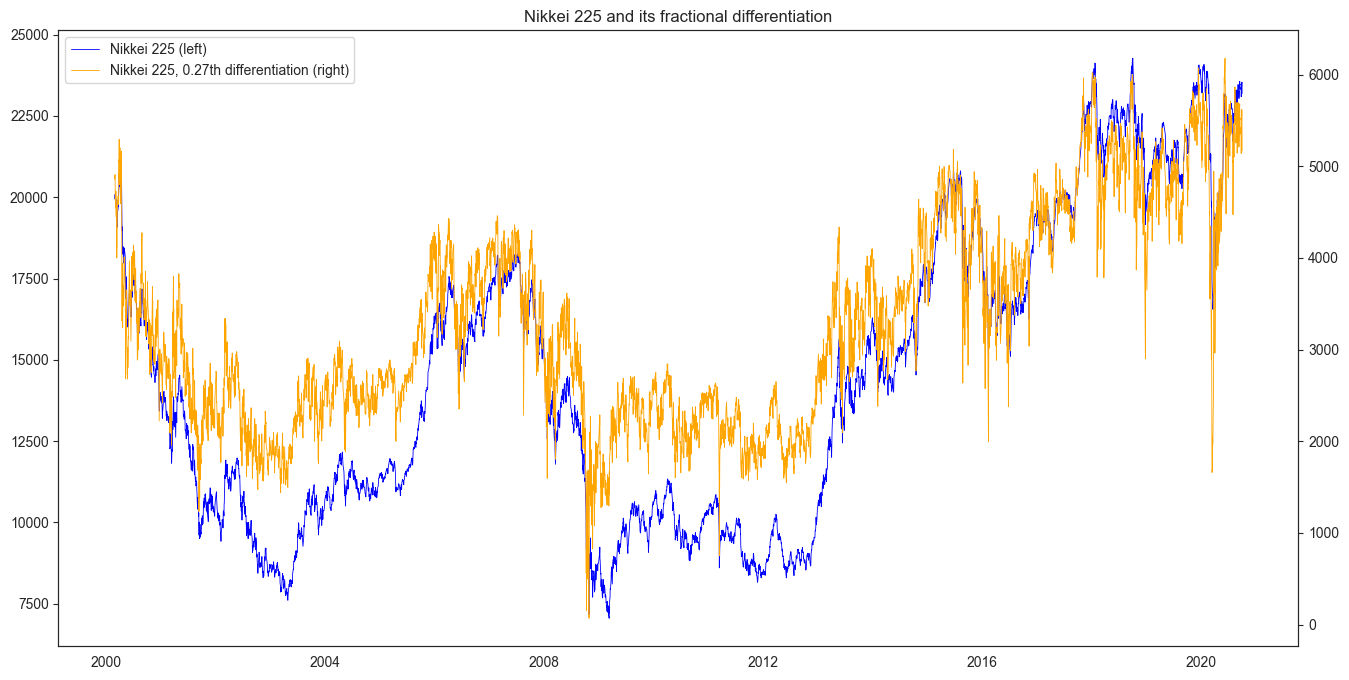Fracdiff performs fractional differentiation of time-series, a la "Advances in Financial Machine Learning" by M. Prado. Fractional differentiation processes time-series to a stationary one while preserving memory in the original time-series. Fracdiff features super-fast computation and scikit-learn compatible API.
See M. L. Prado, "Advances in Financial Machine Learning".
$ pip install fracdifffdiff: A function which extendsnumpy.diffto fractional orders.Fracdiff: Perform fracdiff of a set of time-series. Compatible with scikit-learn API.FracdiffStat: Automatically fracdiff which makes a set of time-series stationary while preserving their maximum memory. Compatible with scikit-learn API.
Fracdiff is blazingly fast.
The following graphs show that Fracdiff computes fractional differentiation much faster than the "official" implementation.
It is especially noteworthy that execution time does not increase significantly as the number of time-steps (n_samples) increases, thanks to NumPy engine.
The following tables of execution times (in unit of ms) show that Fracdiff can be ~10000 times faster than the "official" implementation.
| n_samples | fracdiff | official |
|---|---|---|
| 100 | 0.164 +- 0.088 | 20.725 +- 5.323 |
| 1000 | 0.162 +- 0.055 | 108.049 +- 3.612 |
| 10000 | 0.268 +- 0.085 | 1074.970 +- 89.375 |
| 100000 | 0.779 +- 0.241 | 12418.813 +- 453.551 |
| n_features | fracdiff | official |
|---|---|---|
| 1 | 0.162 +- 0.055 | 108.049 +- 3.612 |
| 10 | 0.229 +- 0.036 | 1395.027 +- 172.948 |
| 100 | 1.745 +- 0.196 | 13820.834 +- 821.352 |
| 1000 | 19.438 +- 2.093 | 154178.162 +- 11141.337 |
(Run on Macbook Air 2018, 1.6 GHz Dual-Core Intel Core i5, 16 GB 2133 MHz LPDDR3)
A function fdiff calculates fractional differentiation.
This is an extension of numpy.diff to a fractional order.
import numpy as np
from fracdiff import fdiff
a = np.array([1, 2, 4, 7, 0])
fdiff(a, n=0.5)
# array([ 1. , 1.5 , 2.875 , 4.6875 , -4.1640625])
np.array_equal(fdiff(a, n=1), np.diff(a, n=1))
# True
a = np.array([[1, 3, 6, 10], [0, 5, 6, 8]])
fdiff(a, n=0.5, axis=0)
# array([[ 1. , 3. , 6. , 10. ],
# [-0.5, 3.5, 3. , 3. ]])
fdiff(a, n=0.5, axis=-1)
# array([[1. , 2.5 , 4.375 , 6.5625],
# [0. , 5. , 3.5 , 4.375 ]])A transformer class Fracdiff performs fractional differentiation by its method transform.
from fracdiff import Fracdiff
X = ... # 2d time-series with shape (n_samples, n_features)
f = Fracdiff(0.5)
X = f.fit_transform(X)For example, 0.5th differentiation of S&P 500 historical price looks like this:
Fracdiff is compatible with scikit-learn API.
One can imcorporate it into a pipeline.
from sklearn.linear_model import LinearRegression
from sklearn.preprocessing import StandardScaler
from sklearn.pipeline import Pipeline
X, y = ... # Dataset
pipeline = Pipeline([
('scaler', StandardScaler()),
('fracdiff', Fracdiff(0.5)),
('regressor', LinearRegression()),
])
pipeline.fit(X, y)A transformer class FracdiffStat finds the minumum order of fractional differentiation that makes time-series stationary.
Differentiated time-series with this order is obtained by subsequently applying transform method.
This series is interpreted as a stationary time-series keeping the maximum memory of the original time-series.
from fracdiff import FracdiffStat
X = ... # 2d time-series with shape (n_samples, n_features)
f = FracdiffStat()
X = f.fit_transform(X)
f.d_
# array([0.71875 , 0.609375, 0.515625])The result for Nikkei 225 index historical price looks like this:
Other examples are provided here.
Example solutions of exercises in Section 5 of "Advances in Financial Machine Learning" are provided here.






